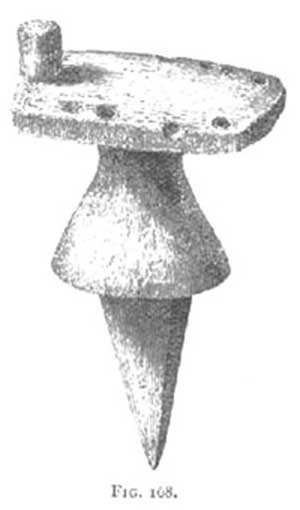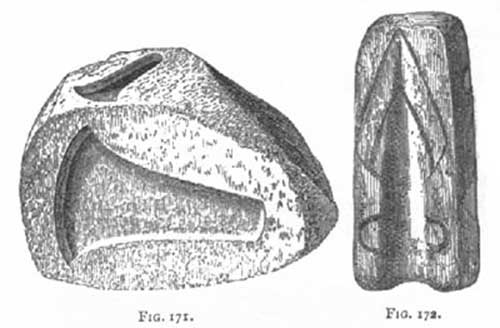Braziers and Founders in Ancient Ireland
From A Smaller Social History of Ancient Ireland 1906
« previous page | contents | start of chapter | next page »
CHAPTER XX....continued
3. Braziers and Founders.
The word goba [gow] is applied to a worker in iron—a smith: cerd or cerdd [caird], to a worker in brass, gold, and silver—a brazier, goldsmith, or silversmith: saer to a carpenter, builder, or mason—a worker in timber or stone. These are the usual applications: but as the arts and trades sometimes overlap, so the words are often applied in somewhat more extended senses.
FIG. 168. Brazier's or Goldsmith's Anvil: natural size; much worn: the little shallow holes were for riveting (From Wilde's Catalogue).
We have already seen that the ancient Irish were very skilful in metallic art. Metallic compounds were carefully and successfully studied, copper commonly forming one of the ingredients. The most general alloy was bronze, formed of copper and tin: but brass, a compound of copper and zinc, was also used. The Irish name for copper was uma [ooa], which is used also to denote both bronze and brass.
FIG. 169. Inlaid hook, natural size. Possibly for suspending a sword. The scroll-work indicates Christian times. Now in National Museum. (From Wilde's Catalogue).
There were two chief kinds of bronze, red and white, or rather reddish and whitish. The red bronze was called derg uma (derg, 'red') or cred-uma, and the white was called finn-uma (finn, 'white'), or findruine [fin-drine]. Findruine was much more expensive than creduma, and was kept for the finer kinds of work. The red bronze may be seen in the spear-heads and caldrons in the National Museum, and the findruine or white bronze in the ornamental shrines, and other ancient works of art.
FIG. 170. Spear held now in National Museum, where many equally or more beautiful are preserved (From Wilde's Catalogue).
Metal-casting is very often referred to in general terms in our literature, showing how familiar it was: and through these incidental references we get now and then a glimpse at the artists' tools and appliances. The workmen used charcoal for their fires, that made from birch-wood, giving the greatest heat then attainable, sufficient—with the help of a flux—to melt all ordinary metals. They used a ladle (Irish, liach) to pour out the melted metal. The exquisite skill of the ancient Irish braziers is best proved by the articles they made, of which hundreds are preserved in our Museum. Two illustrations are given opposite [above] (figs 169 and 170); a beautiful specimen of enamelled metal-work is described at page 417, supra, and shown in fig. 163; and others will be found in various parts of this book, especially in the chapter on Art. The gracefully-shaped spearheads, which, in point of artistic excellence, are fully equal to any of those found in Greece, Rome, or Egypt, were cast in moulds: and we have not only the spear-heads themselves but many of the moulds, usually of stone, proving—if proof was needed—that all these articles were of native manufacture.
FIGS. 171 & 172. Stone Moulds. Fig. 171 in Belfast Museum: fig. 172 in National Museum, Dublin. (From Wilde's Catalogue).
In one glass case in the National Museum there are more than forty moulds for celts, spear heads, arrow-heads, &c.: some looking as fresh as if they had been in use yesterday. The old cairds were equally accomplished in making articles of hammered bronze, of which the most characteristic and important are the beautifully formed caldrons—many of exquisite workmanship—made of a series of bronze plates, hammered into shape and riveted together. Of these, numerous specimens maybe seen in the National Museum; and some are figured in this book (see figs. 107, 108, pp. 352, 353; also fig. 90, p. 315, above).




